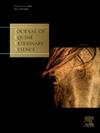Pharmacologically induced ex copula ejaculation in stallions: assessment of new combined protocols
IF 1.3
3区 农林科学
Q2 VETERINARY SCIENCES
引用次数: 0
Abstract
Pharmacologically induced ejaculation is an alternative for semen collection in stallions with different physical or behavioral pathologies affecting mounting or copulation. Several protocols have been studied with varying results, so this is still an active research topic. The aim of this study was assessing different protocols to induce ex copula ejaculation. Healthy stallions (n=8, mean age: 8.7 years, range: 5-22 years) were included. Intervals of two days were left between treatments. The following protocols were performed without sexual prestimulation and administering drugs at the same time: xylazine (0.33mg/kg)+butorphanol (0.02mg/kg) (XB), detomidine (0.01mg/kg)+butorphanol (0.02mg/kg) (DB), detomidine (0.01mg/kg)+butorphanol (0.02mg/kg)+oxytocin (20 IU) (DBO) and xylazine (0.33mg/kg)+detomidine (0.01mg/kg)+butorphanol (0.02mg/kg)+oxytocin (20 IU) (XDBO). Other two protocols were imipramine oral administration (2.5mg/kg) followed by xylazine (0.33mg/kg) +butorphanol (0.02mg/kg) (IXB) or detomidine (0.01mg/kg)+butorphanol (0.02mg/kg)+oxytocin (20 IU) (IDBO) 2 hours later. Besides, XB and DBO were also performed with sexual prestimulation (RXB and RDBO) by 10 min of teasing with an estrous mare. Then, stallions were left in their boxes for 5 min, before drug administration. Semen was collected into a non-spermicidal plastic bag. Interval from treatment to ejaculation (min.), volume (ml) and concentration (sperm x106/ml) of the ejaculate were compared between treatments by one-way ANOVA followed by Bonferroni test. The percentage of stallions that ejaculated post-treatment were compared between groups by Chi-Square test. Differences were considered significant with P<0.05. Values are expressed as mean ± SD (Graph Pad). Ejaculation was observed in 37.5% (3/8) of stallions of XB and RXB, in 25% (2/8) of individuals of DBO and RDBO, in 50% of IDBO (4/8) and in 62.5% (5/8) of IXB. Any stallion of DB or XDBO group ejaculated. Effectiveness for triggering ejaculation was not significantly different between treatments (P=0.06). The mean interval from treatment to ejaculation (min) was 2.01±0.9, 1.7±0.5,1.9±0.7, 1.4±0.14, 1.8±0.4 and 1.9±0.4 for XB, RXB, DBO, RDBO, IXB and IDBO, respectively, without significant differences between groups. The mean ejaculate volume was greater in stallions of RXB (31.7±8.5 ml) than in all other protocols (P˂0.01), except for RDBO (13.8±3.8ml). Mean ejaculate concentration was greater in individuals of DBO (723 ± 5 sperm x106/ml), IDBO (672±62 sperm x106/ml) and IXB (786±56 sperm x106/ml), than in those of RXB (262 ± 170 sperm x106/ml) (P˂0.01). In conclusion, except for DB and XDBO, all protocols were effective in triggering ejaculation in some stallions. Sexual prestimulation only increased the ejaculate`s volume in stallions treated with xylazine+ butorphanol. As not all individuals ejaculate with all protocols, several trials using different treatments should be performed in case of failure to obtain semen. The present study provides evidence for different possible alternatives.
药理学诱导的种马非交配射精:新联合方案的评估
药理学诱导射精是一种可选择的精液收集的种马不同的身体或行为病理影响骑或交配。已经研究了几种方案,结果各不相同,因此这仍然是一个活跃的研究课题。本研究的目的是评估不同的方案诱导性交前射精。健康种马8匹,平均年龄8.7岁,范围5-22岁。两次治疗间隔两天。在不进行性预刺激的情况下,同时给药:木嗪(0.33mg/kg)+丁托啡诺(0.02mg/kg) (XB)、德托咪定(0.01mg/kg)+丁托啡诺(0.02mg/kg) (DB)、德托咪定(0.01mg/kg)+丁托啡诺(0.02mg/kg)+催产素(20 IU) (DBO)和木嗪(0.33mg/kg)+德托咪定(0.01mg/kg)+丁托啡诺(0.02mg/kg)+催产素(20 IU) (XDBO)。其他两种方案为丙咪嗪口服(2.5mg/kg), 2小时后再用噻嗪(0.33mg/kg) +丁托啡诺(0.02mg/kg) (IXB)或托咪定(0.01mg/kg)+丁托啡诺(0.02mg/kg)+催产素(20 IU) (IDBO)。此外,XB和DBO还与性预刺激(RXB和RDBO)一起进行,通过与发情母马进行10分钟的挑逗。然后,在给药之前,将种马放在它们的盒子里5分钟。精液被收集到一个非杀精塑料袋中。治疗至射精间隔时间(min)、射精体积(ml)和浓度(精子x106/ml)采用单因素方差分析,并进行Bonferroni检验。治疗后射精的种马百分比组间比较采用卡方检验。p < 0.05认为差异显著。数值以mean±SD (Graph Pad)表示。XB和RXB的37.5%(3/8)、DBO和RDBO的25%(2/8)、IDBO的50%(4/8)和IXB的62.5%(5/8)都能射精。DB或XDBO组的任何种马都射精了。两组间射精效果无显著性差异(P=0.06)。XB、RXB、DBO、RDBO、IXB和IDBO治疗至射精的平均间隔时间(min)分别为2.01±0.9、1.7±0.5、1.9±0.7、1.4±0.14、1.8±0.4和1.9±0.4,组间差异无统计学意义。除RDBO(13.8±3.8ml)外,RXB种马的平均射精量(31.7±8.5 ml)高于所有其他方案(P值小于0.01)。DBO组(723±5个精子x106/ml)、IDBO组(672±62个精子x106/ml)和IXB组(786±56个精子x106/ml)的平均射精浓度高于RXB组(262±170个精子x106/ml) (P小于0.01)。综上所述,除DB和XDBO外,所有方案对某些种马的射精都是有效的。性预刺激只增加了经噻嗪+丁托啡诺处理的公马的射精量。由于不是所有的人都能射精,所以在无法获得精液的情况下,应该进行几种不同治疗方法的试验。本研究为不同可能的替代方案提供了证据。
本文章由计算机程序翻译,如有差异,请以英文原文为准。
求助全文
约1分钟内获得全文
求助全文
来源期刊

Journal of Equine Veterinary Science
农林科学-兽医学
CiteScore
2.70
自引率
7.70%
发文量
249
审稿时长
77 days
期刊介绍:
Journal of Equine Veterinary Science (JEVS) is an international publication designed for the practicing equine veterinarian, equine researcher, and other equine health care specialist. Published monthly, each issue of JEVS includes original research, reviews, case reports, short communications, and clinical techniques from leaders in the equine veterinary field, covering such topics as laminitis, reproduction, infectious disease, parasitology, behavior, podology, internal medicine, surgery and nutrition.
 求助内容:
求助内容: 应助结果提醒方式:
应助结果提醒方式:


